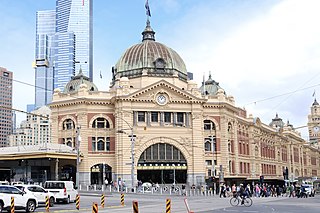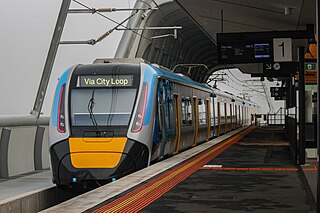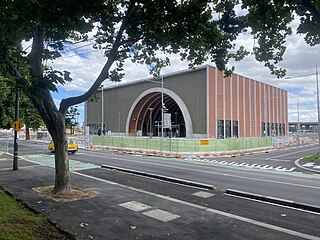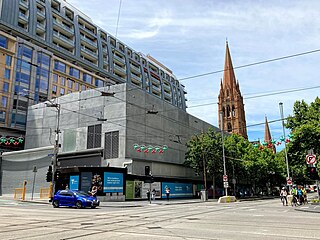
Flinders Street railway station is a train station located on the corner of Flinders and Swanston streets in Melbourne, Victoria, Australia. It is the busiest train station in Australia, serving the entire metropolitan rail network, 15 tram routes travelling to and from the city, as well as some country and regional V/Line services to eastern Victoria. Opened in 1854, the station is the oldest in Australia, backing onto the Yarra River in the central business district, the complex includes 13 platforms and structures that stretch over more than two city blocks, from east of Swanston Street to nearly at Market Street.

The City Loop is a piece of underground commuter rail infrastructure in the central business district (CBD) of Melbourne, Victoria, Australia

State Library Victoria (SLV) is the state library of Victoria, Australia. Located in Melbourne, it was established in 1854 as the Melbourne Public Library, making it Australia's oldest public library and one of the first free libraries in the world. It is also Australia's busiest public library and, as of 2023, the third busiest library globally.

Parliament railway station is a commuter railway station adjacent to the border between the Melbourne CBD and the suburb of East Melbourne, in Victoria, Australia. The station has two island platforms in a two-floor configuration, connected to street level via two underground concourses.

Flagstaff railway station is an underground station on the metro network in Melbourne, Australia. It is one of three stations on the underground City Loop, which runs through the Melbourne CBD. The station takes its name from the nearby Flagstaff Hill, a significant site in Melbourne's early history, and services Melbourne's legal district. It runs under La Trobe and William streets, near the north western corner of the CBD.

Proposals for expansion of the Melbourne rail network are commonly presented by political parties, government agencies, industry organisations and public transport advocacy groups. The extensions proposed take a variety of forms: electrification of existing routes to incorporate them into the suburban rail system; reconstruction of former passenger rail lines along pre-existing easements; entirely new routes intended to serve new areas with heavy rail or provide alternative routes in congested areas; or track amplification along existing routes to provide segregation of services. Other proposals are for the construction of new or relocated stations on existing lines, to provide improved access to public transport services.

The Pakenham line is a commuter railway line in the city of Melbourne, Victoria, Australia. Operated by Metro Trains Melbourne, it is the city's longest metropolitan railway line at 57 kilometres (35 mi). The line runs from Flinders Street station in central Melbourne to Pakenham station in the south-east, serving 27 stations via the City Loop, South Yarra, Caulfield, Oakleigh, and Dandenong. The line operates for approximately 20 hours a day with 24 hour service available on Friday and Saturday nights. During peak hour, headways of up to 5 to 10 minutes are operated with services every 20 minutes during off-peak hours. Trains on the Pakenham line run with a seven-car formation operated by High Capacity Metro Trains.

The Cranbourne line is a commuter railway line in the city of Melbourne, Victoria, Australia. Operated by Metro Trains Melbourne, it is the city's second longest metropolitan railway line at 44 kilometres (27 mi). The line runs from Flinders Street station in central Melbourne to Cranbourne station in the south-east, serving 24 stations via the City Loop, South Yarra, Caulfield, Oakleigh, and Dandenong. The line operates for approximately 20 hours a day with 24 hour service available on Friday and Saturday nights. During peak hour, headways of up to 5 to 15 minutes are operated with services every 15–20 minutes during off-peak hours. Trains on the Cranbourne line run with a seven-car formation operated by High Capacity Metro Trains.

The Mernda line is a commuter railway line in the city of Melbourne, Victoria, Australia. Operated by Metro Trains Melbourne, it is the city's eighth longest metropolitan railway line at 33.1 kilometres (20.6 mi). The line runs from Flinders Street station in central Melbourne to Mernda station in the north, serving 29 stations including Clifton Hill, Reservoir, Epping, and South Morang. The line operates for approximately 19 hours a day with 24-hour service available on Friday and Saturday nights. During peak hour, headways of up to 7.5 minutes are operated with services every 10–30 minutes during off-peak hours. Trains on the Mernda line run with two three-car formations of X'Trapolis 100 trainsets.

Melbourne Central railway station is an underground station on the electrified railway network in Melbourne, Australia. It is one of three underground stations on the City Loop, which runs through the north and east of the Melbourne CBD.

The City Square was a public plaza located in the Central Business District (CBD) of Melbourne, Victoria, Australia. The site was bounded by Swanston Street, Collins Street, Flinders Lane and the Westin Hotel. The historic landmarks of Melbourne Town Hall and St Paul’s Cathedral were across the streets to the north and south respectively.

The Melbourne central business district is the city centre and main urban area of the city of Melbourne, Victoria, Australia, centred on the Hoddle Grid, the oldest part of the city laid out in 1837, and includes its fringes. The Melbourne CBD is located mostly in the local government area of the City of Melbourne, which also includes some of inner suburbs adjoining the CBD, while a small section extends into the City of Port Phillip.

The Metro Tunnel is a metropolitan heavy rail project currently under construction in Melbourne, Victoria, Australia. It includes the construction of twin 9-kilometre (5.6 mi) rail tunnels between South Kensington and South Yarra with five new underground stations. The tunnel will connect the Pakenham and Cranbourne lines with the Sunbury line, creating a new high-frequency cross-city line that bypasses Flinders Street station and the City Loop. The line is also planned to serve Melbourne Airport via a new branch line west of Sunshine.

Parkville railway station is part of the Metro Tunnel project in Melbourne, Victoria. It has been built below Grattan Street, between Leicester and Elizabeth streets, using the cut-and-cover method. Construction commenced in 2018 and was completed in May 2024, but the station is yet to open. It will serve the large health and education precinct in the Melbourne suburb of Parkville, including the University of Melbourne, the Royal Melbourne Hospital and the Royal Women's Hospital.

Arden railway station is a railway station In Melbourne, constructed as part of the Metro Tunnel project. When opened, it will be served by the Sunbury, Pakenham and Cranbourne lines. Located in North Melbourne, below Laurens and Arden Streets, it was constructed using the cut-and-cover method. Major construction commenced in April 2018, and was completed in January 2024.

Melbourne Airport Rail is a proposed rail link from the Melbourne CBD to Melbourne Airport at Tullamarine. Since October 2022, the project has also been considered as part of the Suburban Rail Loop (SRL) and branded as SRL Airport. The rail link will run through the under-construction Metro Tunnel, running 27 km from the airport to Town Hall station in the city centre with 12 km of new track between the airport and Sunshine station. The link will be a new branch of the Melbourne Metro rail network and run High-Capacity Metro Trains at a 10-minute frequency. The project is being delivered by the Victorian state government agency Rail Projects Victoria.

Sydney Metro City & Southwest is a 30-kilometre (19 mi) rapid transit project currently under-construction in Sydney, Australia. The project will extend the Metro North West Line from Chatswood on the North Shore, to Bankstown in the city's south-west via the Sydney central business district.

The High Capacity Metro Train (HCMT) is a type of electric multiple unit (EMU) train for use by Metro Trains Melbourne on the Melbourne rail network. The first train set entered service on 27 December 2020 and will become the primary rolling stock used in the Metro Tunnel when it opens in 2025.

Town Hall railway station is a rapid transit station currently under construction as part of the Metro Tunnel project in Melbourne, Victoria. The station will serve the southern end of the Melbourne central business district (CBD) and will connect to Flinders Street station via an underground pedestrian walkway.

The Suburban Rail Loop (SRL) is a group of new rapid transit lines planned or under construction in Melbourne, Victoria, Australia. The project is divided into four distinct sections. The two main sections, SRL East and SRL North, would together form a single 60 km (37 mi) fully automated orbital metro line through the city's middle suburbs, with 13 stations between Cheltenham and Melbourne Airport connecting to eight existing Melbourne rail lines. SRL East is currently under construction and is planned to open in 2035.






















